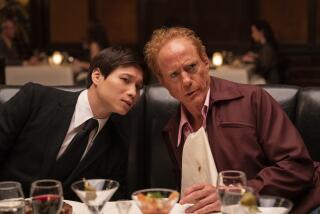Movie review: ‘Project Nim’
In late November 1973, a young woman from New York went to Norman, Okla., to adopt the newest and youngest member of her family. It wasn’t a human baby she was bringing home to Manhattan, however, but rather a 2-week-old chimpanzee, destined to be part of an audacious experiment to see if a member of another species could be taught to communicate with humans.
The unforeseen ways that notion played out over the next two dozen years is the subject of James Marsh’s unsettling “Project Nim,” which won the best directing award for world documentary at Sundance.
What makes this film especially engrossing is that what happened between that chimp and the humans with whom he spent his life in intimate contact turns out to be only half the story that Marsh, who directed the electrifying “Man on Wire,” has to tell.
Through no fault of his own, Nim’s life turned out to be a flesh-and-blood Rorschach test that revealed as much about human nature as it did about the capabilities of chimpanzees. Almost everyone wanted a piece of Nim; almost everyone used him for their own purposes. The chaos caused by the interaction between this creature plucked from his kind and the conceit and self-interest of complex individual egos and emotions is as involving as it sounds.
Marsh is a superb interviewer, and the key participants in Nim’s story are far enough removed in time to be candid about what happened but not so far away to have forgotten the details. Though he has a weakness for occasional unsatisfactory re-enactments, Marsh also makes excellent use of the large amount of still and movie footage shot then that shows us exactly what Nim and his human cohorts were up to.
It was Columbia University behavioral psychologist Herbert Terrace who came up with the idea of placing a chimp in a human family to see if it could be taught American Sign Language. And it was one of Terrace’s graduate students, Stephanie LaFarge, who was Nim’s original surrogate mother. The name Nim Chimpsky is a play on Noam Chomsky, the celebrated linguist who believed that language, specifically the ability to string words together to form sentences, is an exclusively human trait.
LaFarge had recently remarried, and her blended family of seven children lived in a brownstone on New York’s Upper West Side that became Nim’s new home. If you’re thinking this was a group decision, you would be wrong.
“There was no discussion, it just happened,” remembers Jenny Lee, LaFarge’s acerbic daughter. And her mother, who admits she “liked the freedom to defy expectations and authority,” makes no bones about the fact that “my appetite and drive to have an intimate relationship with an animal was unstoppable.”
Not surprisingly, this drive ran into some real-world problems. For one thing, LaFarge was not prepared for what she calls “the wild animal in Nim,” and LaFarge’s husband didn’t expect the immediate full-bore hostility from a chimp hard-wired to challenge male authority figures.
All of this was intensified by growing conflicts between Terrace, who consistently comes off as cold and arrogant, and Earth mother-type LaFarge, who’d once been his lover. When the professor came over to assess Nim’s progress, LaFarge’s daughter Lee remembers with revulsion, it was like a visit from God.
Unhappy with what he considered a lack of order, Terrace gave increasing organizational authority to a bright, highly motivated (and, not surprisingly, quite attractive) 18-year-old student named Laura-Ann Petitto. The philosophical differences between her and LaFarge were so intense that the distaste each one feels for the other is undiminished to this day.
While even these few events are emotional enough to bring a scientific drama to a boil, more was in store for Nim, much more. There was significant turnover in caregivers, multiple changes of venue, even radical alterations in Terrace’s thinking about whether chimps could in fact be taught to learn language in any meaningful way. Trapped in a world he never made, a no-man’s land between species, Nim did the best he could, and even doing that much turned out to be difficult.
Looking back on Nim now, LaFarge feels “we had done so much damage removing him from what his life should have been, it was wrong.” Speaking even more strongly is Joyce Butler, one of his signing teachers. “We did a huge disservice to him and his soul, and shame on us,” she says, just about in tears, and seeing this eye-opening film makes it impossible to argue the point.
More to Read
The biggest entertainment stories
Get our big stories about Hollywood, film, television, music, arts, culture and more right in your inbox as soon as they publish.
You may occasionally receive promotional content from the Los Angeles Times.







